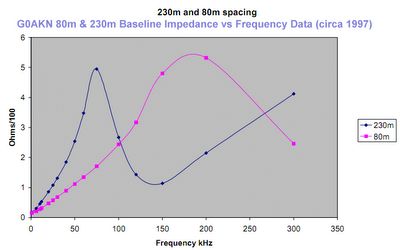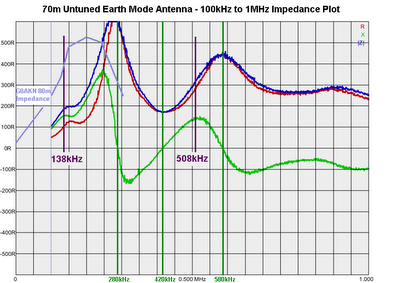Earth Mode Antenna Measurements - Part 2
Experiment to determine if there is any correlation with measurements made by John - G0AKN (SK) some years ago in the UK.
The antenna configuration measured is the temporary 70m earth-mode setup where a connection is made between a set of three earth rods at the bottom of the block and a single station earth rod near the front. The connections are temporary just consisting of alligator-teethed jumper wires attached to various points.
As mentioned in a previous experiment, I am curious to see if impedance measurements made by John - G0AKN (SK) circa 1997 in the UK have any correlation to measurements made at this QTH on the 70m temporary earth-mode antenna (EMA).
From his very interesting booklet (which can be downloaded from here) I have captured below a graph done by G0AKN of impedance versus frequency for two baselines - 80m and 230m... (click graphic for a larger view...)
The curve for 80m is of particular interest as it is close to the 70m baseline used here for the temporary EMA. If there is some correlation the first impedance peak should be lower in frequency for the G0AKN 80m baseline compared to the VK2XV 70m baseline EMA.
Reading off some points from G0AKN's graph and plotting them on the VK2XV impedance graph produced this result... (click graphic to see larger view...)
The G0AKN data can be seen on the left as the pale blue curve.
It is remarkable in its correlation as indeed the first impedance peak is lower in frequency for the G0AKN EMA just where it would be expected to be by adjusting for the ratio 70m/80m. Given the dimension quoted of 80m for G0AKN's EMA may be rough and the estimated 70m for the VK2XV, and considering the peak and trough positions are also influenced by the characteristics of the ground over which the EMA is placed, the correlation is strong.
It is intended to construct the permanent 80m EMA (actually Google-Earth suggests closer to 90m) at this QTH in such a way as to allow different length configurations and feed points to measured and compared.

